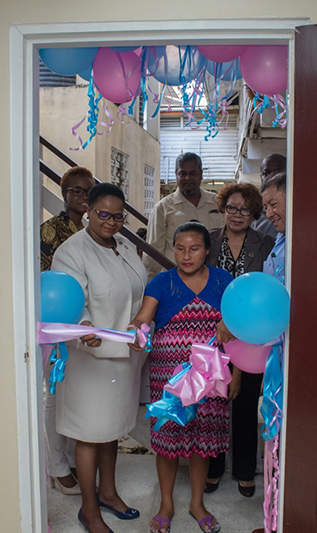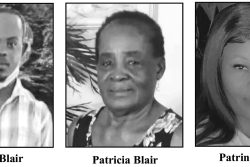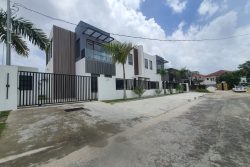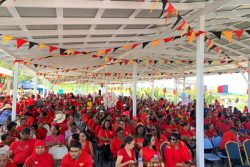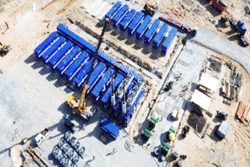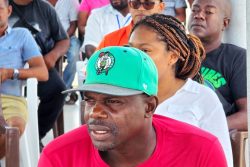Expectant mothers brought to the city from hinterland locations for medical treatment will now be accommodated at an improved maternity waiting home which was commissioned on Wednesday at the Indigenous Residence in Georgetown.
Maternity waiting homes are, in essence, residential facilities located near qualified medical institutions where pregnant woman who are considered to be “high risk” are brought to await the delivery process.
It was noted that the recently rehabilitated waiting home at the Indigenous residence located at Princes Street, Charlestown is a component of a larger project funded by the Inter-American Development Bank (IDB) as part of efforts to reduce maternal, perinatal and neonatal deaths in Guyana.
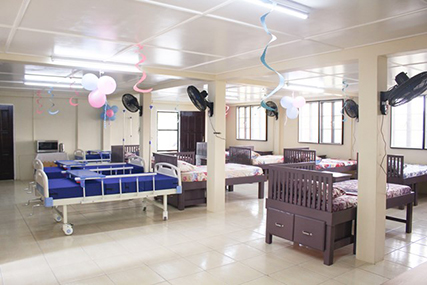
The project, as explained by Pauline Welch, Senior Social Worker, Welfare and Health at the Ministry of Indigenous Peoples’ Affairs, has three aspects. These focus on strengthening of reproductive, maternal and neonatal health services, strengthening the healthcare network and administration and evaluation.
“It’s not just a waiting home in Georgetown but there is also some work being done at the C.C Nicholson Hospital in Berbice, purchases of vehicles and important equipment such as radio sets for the facilities in regions 3,4 and 9,” she added.
Stabroek News understands that the rehabilitation of the maternity waiting home at the Indigenous residence which was done at a cost of US$3,534 now allows an additional 10 beds, bringing the total number of available beds to 32.
It was noted too that rehabilitation of the home began in February, with a section of the residence undergoing renovation before the new facility was set-up. The rehabilitated home is the third of three that currently exist.
Other homes are said to be located in Suddie, on the Essequibo Coast and Lethem in Region Nine, with one currently under construction in Annai, also in Region Nine that is being co-financed by the IDB and another expected to be constructed in Moruca in the near future.
Meanwhile, Minister of Public Health Volda Lawrence, who was the keynote speaker at the event reiterated that the rehabilitated home forms part of her Ministry’s mandate to increase access to health services and reduce maternal deaths by bridging the geographical barriers that hinder access to health care.
“According to the WHO (World Health Organisation), many consider maternity waiting homes to be a key element of a strategy to bridge the geographical gap. That gap that they are talking about is in obstetric care between rural areas with poor access to equipped facilities and urban areas where the services are available. As one component of a comprehensive package of essential obstetric services, maternity waiting homes may offer a low cost way to bring women closer to needed obstetric care,” Lawrence posited.
“I want to offer my sincere congratulations and hope that this facility will serve as a comfortable and caring home away from home where your health and pregnancies can be monitored and safe delivery procedures can be ensured. It would certainly be remiss of me not to say thank you to the agency responsible for all of our waiting homes in Guyana, this agency is none other than the IDB from whom the Ministry of Finance was able to secure a loan for the Ministry of Public Health to improve maternal and child health in Guyana,” the Minister added.
Similar sentiments were shared by Minister of Indigenous Peoples’ Affairs Sydney Allicock who noted that there has been a demand for facilities of this kind over the years.
“Over the years we have recognized that there is a need for such a facility and over the last short three years we have been able to add to what we’ve had here… As you know, our population mainly in the indigenous communities have been advancing and we have to take care of those young people,” the Minister said.
Allicock also took the opportunity to lobby for there to be more communication between residents of the hinterland and the ministries to allow for better comprehension of what services are needed.
“I would also like to say to the communities that you all come from, that we all have a role to play and that is simply allowing us at the Ministry here to understand what is happening back home and to keep that communication link through health, through the Ministry of Indigenous Peoples’ affairs so that we can be in a better position to deliver services that will allow you safety and a better life,” the Minister remarked.
“We are aware of the difficulties in the hinterland, how difficult it is to get out here, how long it takes to return or recover and how sometimes you may not be comfortable with your food but we are looking at all these things to give you the best that we could,” he added.
